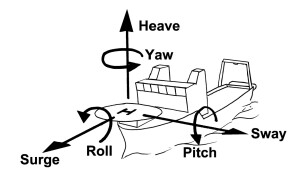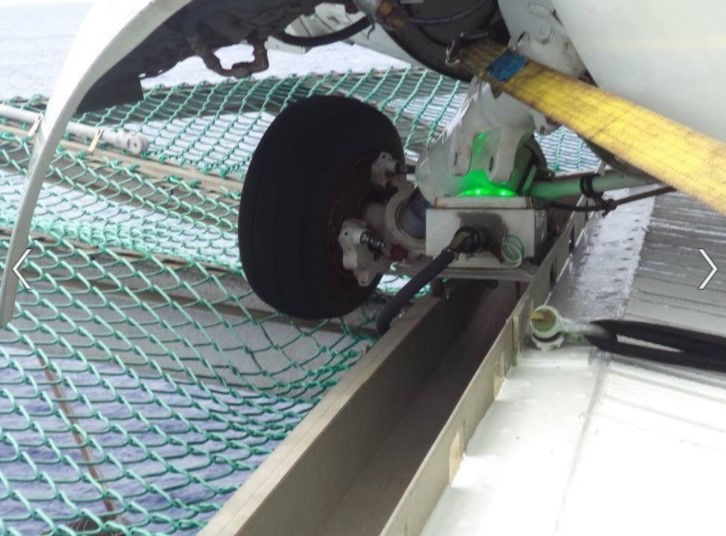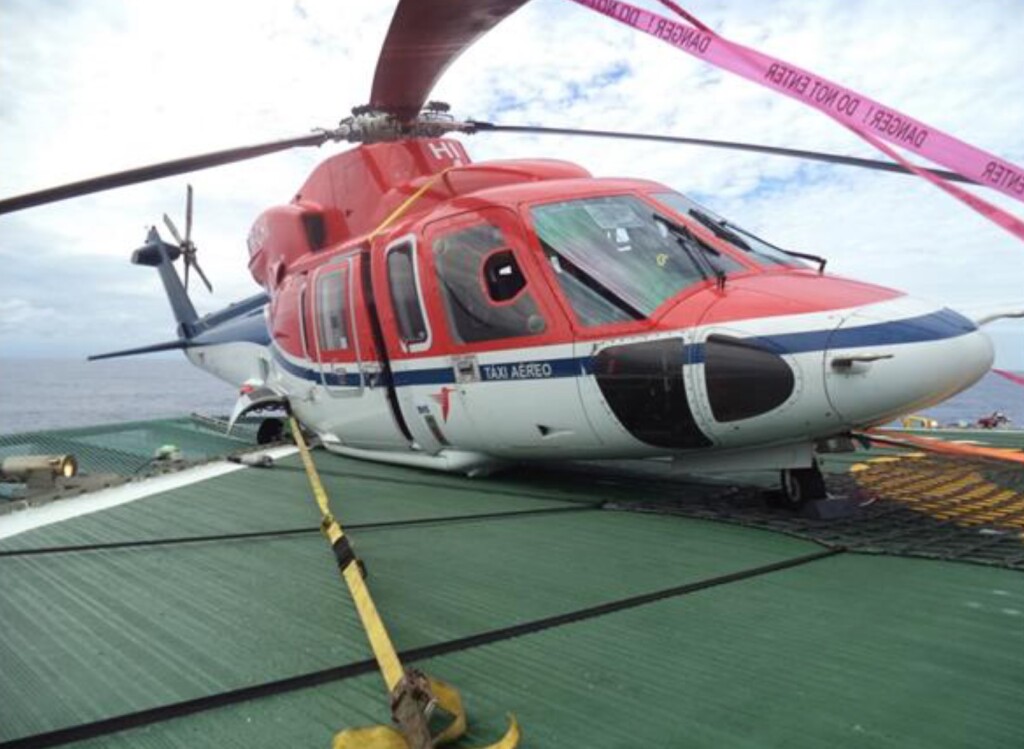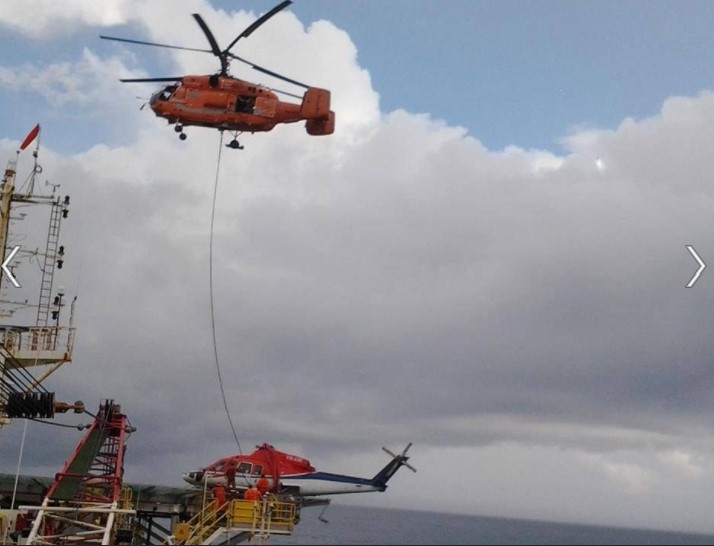Helideck Heave Ho! (BHS Sikorsky S-76C++ PR-CHI)
On 16 February 2014 Sikorsky S-76C++ PR-CHI of CHC‘s Brazilian Helicopter Services was damaged when landing on the bow deck of the drillship Aban Abraham while on charter to Brazilian state oil and gas company Petrobras.
According to the Centro de Investigação e Prevenção de Acidentes Aeronáuticos (CENIPA) safety investigation report (finally released 16 November 2021 in Portuguese only) the helicopter had departed Cabo Frio Airport (SBCB) at 07:12 Local Time. It was to route to Aban Abraham NS07 (9PDA), then the Petrobras P-63 FPSO (9PHD), back to the Aban Abraham and then returning to Cabo Frio.
Details of the helideck pitch, roll and heave (P/R/H) was not available when the aircraft departed Cabo Frio but were to be radioed by each vessel no later than 20 minutes before landing.
During the third sector from P-63 to Aban Abraham the drillship’s radio operator reported the P/R/H was “within the limits for landing”. The data came from the vessel’s Helideck Monitoring System (HMS) and limits had been set that “were known to the [helicopter] crew and [drillship] radio operator”. However, CENIPA do not detail the limits in use in their report.
According to CENIPA:
…minutes before, there had been variations in P/R/H greater than the maximum permissible for the operation of the aircraft, which were not reported.
No document or standard was found that contained instructions for the radio operator about the time interval to be considered when reading the maximum P/R/H values of the helideck on the HMS…
Indeed CENIPA state that the HMS also showed “several peaks of heave above the limits” shortly before the landing. However, the CENIPA report unhelpfully includes no HMS or FDR data.
The flight crew “performed a direct approach for landing” and perceived “some more prominent movements of the helideck” once they were below 500 ft. They “considered the possibility of a go-around…about one minute before the occurrence” but decided to continue.
Ultimately there was a heave that ‘surprised them”, followed by a second one about 2 seconds later that resulted in an abnormal contact between the helideck and the right main landing gear, which collapsed.
The helicopter was shut down and all 12 occupants safely disembarked.
The helicopters was subsequently removed as an underslung load by a Kamov Ka-32.
CENIPA Analysis
Firstly CENIPA state:
…the lack of a time interval [defined in regulation] to be considered by the radio operator for reading the P/R/H data on the HMS…in order to determine a safe condition for landing inside operating limits, contributed to the occurrence, as it allowed the crew to proceed to the landing at the helideck with information different from that actually found by the aircraft at the time of landing.
While this is a sound systemic focus, the investigators decided with hindsight bias, to use the crew’s candour against them by determining…
…the piloting judgment of the crew also contributed to the event, since despite having perceived more relevant movements of the helideck and having been considered a go-around, the pilots decided to proceed with the landing, judging that the conditions were favourable, thus highlighting a deficiency in the assessment of the scenario…
This is a classic case of Catch 22 in a safety investigation. A statement that indicated the crew had failed to notice high levels of heave would potentially have resulted in a determination that lack of attention was contributor, while mentioning worsening conditions is judged as a failure to act.
Safety Actions
CENIPA report that:
In May 2014, at a meeting involving Petrobras and offshore air taxi operators, a Technical Order was updated… …it was established that this relevant information should be the peaks of pitch/roll/heave in the last 20 minutes.
Its not clear why this had not been addressed previously. In the UK both CAP437 and industry guidance at least 10 years before the incident earlier had required the peak values to be from a minimum of 10 minutes of observations to be reported (since extended to 20 minutes). This had actually be shared by a industry oil and gas industry association that Petrobras are a member of in January 2002!
However, there is even more to this…
Wider Background: Helideck Safety Standards Progress and Implementation Inertia
The helideck heave limitation was actually replaced by in the UK by heave rate in November 2010. The UK CAA explain in CAP437 that:
Heave rate is considered to be a more appropriate parameter and has been used in the Norwegian sector for many years.
This is explained further in UK CAA Paper 2008/03 Helideck Design Considerations – Environmental Effects.
The Helideck Certification Agency (HCA) Standard Measuring Equipment for Helideck Monitoring System (HMS) and Weather Data, now at Rev 9b, is referenced by UK CAA and has been adopted as a standards by Bristow, CHC, NHV and OHS (formerly Babcock Offshore) for use on moving helidecks in Europe. This includes a requirement for repeater lights on the helideck to directly warn flight crews of deteriorating conditions both before and after landing.
More significantly, on 17 December 2020 the UK CAA issued Safety Directive SD-2020/003 Offshore Helicopter Helideck Operations (UPDATE superseded by SD-2022/001 on 1 June 2022) that states:
From 1 April 2021, a specified operator must not conduct commercial air transport offshore operations to an offshore location if the helideck motion exceeds stable deck conditions unless that location has a Helideck Monitoring System (HMS) meeting Rev.9 or later version of the HMS standard published on the Helideck Certification Agency’s web site, or provisions as are approved by the CAA.
A stable deck is defined as helideck pitch or roll of 1° or less, and a heave rate of 0.4 m/s or less. In most cases this would be a highly penalising limitation for vessels needing to conduct routine offshore helicopter operations. There have been major practical implementation issues to this safety directive, partly because each HMS’s software needed to be independently assessed and partly in supply of suitable deck lights, but the UK CAA has pragmatically issued extensions to vessel owners who have been proactive and placed purchase orders for upgrades.
UK CAA Safety Directive SD-2020/003 also applied fire-fighting requirements and a need to implement the so called Circle and H lighting upgrade for night operations. The latter incorporated a lighting scheme described in the 2013 CAP1077: Specification for an Offshore Helideck Lighting System. The Safety Directive was also linked to the final closure of safety recommendations from the AAIB reports into the rollover of AS332L G-BKZE on the drillship West Navion on 10 November 2001 and the water impact of EC225 G-REDU on approach to the ETAP Central Production Facility on 18 February 2009.
These safety improvements by the UK CAA, which apply retrospectively to existing existing too (as well as new build facilities), are disappointingly yet to be adopted by international oil and gas industry associations.
Safety Resources
The European Safety Promotion Network Rotorcraft (ESPN-R) has a helicopter safety discussion group on LinkedIn. You may also find these Aerossurance articles of interest:
- Helideck Safety Alerts: Refuelling Hoses and Obstructions
- NTSB Recommendations on Offshore Gas Venting
- Mind the Handrail! – Walk-to-Work Helideck Hazard
- Passive Fire-Retarding Helideck Designs
- US BSEE Helideck A-NPR / Bell 430 Tail Strike
- Troublesome Tiedowns
- Helideck and Helicopter Egress Training Facilities
- Wrong Deck Landings
- FOD and an AS350B3 Accident Landing on a Yacht in Bergen
- Helideck Lightning Strike: Damage Missed
- Pedestrian Seriously Injured by Air Ambulance Landing at Melbourne Hospital
- Air Methods AS350B3 Air Ambulance Tucson Tail Strike
- Air Ambulance B407 Hospital Helipad Deck Edge Tail Strike During Shallow Approach
- NTSB on LA A109S Rooftop Hospital Helipad Landing Accident
- Air Ambulance Helicopter Fell From Kathmandu Hospital Helipad (Video)
- Offshore Night Near Miss: Marine Pilot Transfer Unintended Descent
- BFU Investigate S-76B Descending to 20ft at 40 kts En Route in Poor Visibility
- Night Offshore Windfarm HEMS Winch Training CFIT
- SAR Helicopter Loss of Control at Night: ATSB Report
- NTSB Investigation into AW139 Bahamas Night Take Off Accident
- Loss of Control, Twice, by Offshore Helicopter off Nova Scotia
- NTSB Report on Bizarre 2012 US S-76B Ditching
- S-76C+ MLG Collapsed Due to Pothole
- Loss of Bell 412 off Brazil Remains Unexplained
- UPDATE 8 May 2022: HeliOffshore 2022 Conference Review
- UPDATE 14 May 2022: Review of “The impact of human factors on pilots’ safety behavior in offshore aviation – Brazil”
- UPDATE 4 February 2023: S-92A Offshore Landing Obstacle Strike: CENIPA Report
- UPDATE 11 February 2023: Urgent Exit Required: A Helideck Incident (Omni Sikorsky S-76C+ PR-SEC)







Recent Comments